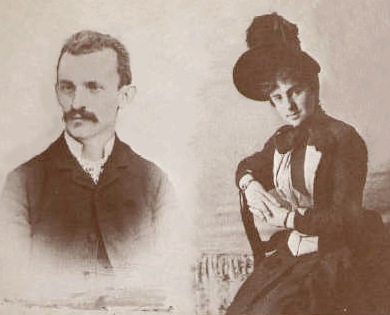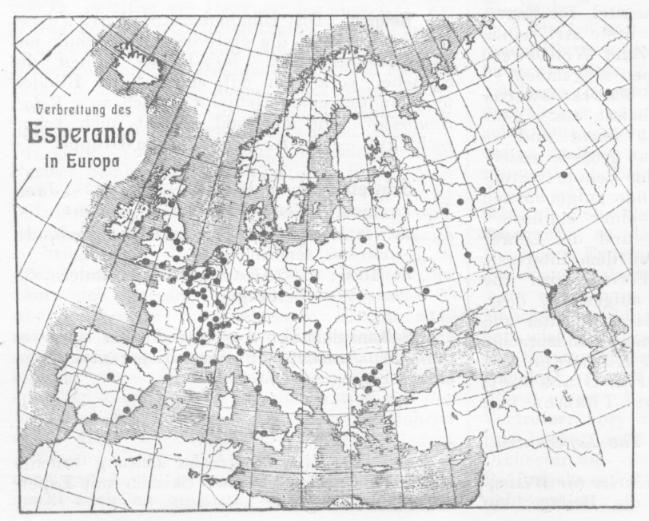|
Occidental Language
Interlingue (; ISO 639 ''ie'', ''ile''), originally Occidental (), is an international auxiliary language created in 1922 and renamed in 1949. Its creator, Edgar de Wahl, sought to achieve maximal grammatical regularity and natural character. The vocabulary is based on pre-existing words from various languages and a derivational system which uses recognized prefixes and suffixes. Many of Interlingue's derived word forms reflect those common to certain Western European languages, primarily the Romance languages, along with some Germanic vocabulary. Many of its words are formed using de Wahl's rule, a set of rules for regular conversion of all but six verb infinitives into derived words including from Latin double-stem verbs (e.g. ''vider'' to see and its derivative ''vision''). The result is a naturalistic and regular language that is easy to understand at first sight for individuals acquainted with certain Western European languages. Readability and simplified grammar, along ... [...More Info...] [...Related Items...] OR: [Wikipedia] [Google] [Baidu] |
Edgar De Wahl
Edgar Alexei Robert von Wahl or de Wahl (23 August 1867 – 9 March 1948) was a Baltic German teacher, mathematician and linguist. He is most famous for being the creator of Interlingue (known as Occidental throughout his life), a naturalistic constructed language based on the Indo-European languages, which was initially published in 1922. De Wahl was born in Olwiopol (according to some sources in Bohopil, a town nearby), Kherson Governorate, Russian Empire (now part of Pervomaisk, Mykolaiv Oblast, Ukraine). The family spent several years in Ukraine, since de Wahl's father worked there as a railway engineer. After that the family stayed for several years in Tallinn and then moved to Saint Petersburg. Wahl studied there and then began service in the Imperial Russian Navy. Beginning in 1894, de Wahl worked as a teacher in Tallinn. De Wahl first became an adherent of Volapük after being introduced to the language by Waldemar Rosenberger (a colleague of de Wahl's f ... [...More Info...] [...Related Items...] OR: [Wikipedia] [Google] [Baidu] |
Bombing Of Tallinn In World War II
During World War II, the Estonian capital Tallinn suffered from many instances of aerial bombing by the Soviet air force and the German Luftwaffe. The first bombings by Luftwaffe occurred during the Summer War of 1941 as part of Operation Barbarossa. A number of Soviet bombing missions to then German-occupied Tallinn followed in 1942–1944. The largest of the Soviet bombings occurred on 9–10 March 1944 in connection with the Battle of Narva and is known as the March bombing ( et, märtsipommitamine). After Soviet saboteurs had disabled the water supply, over a thousand incendiary bombs were dropped on the town, causing widespread fires and killing 757 people, of whom 586 were civilians and 75 prisoners of war, wounding 659, and leaving over 20,000 people without shelter. The Soviet bombings left a legacy of prolonged anti-Soviet resistance and resentment amongst the civilian population of Estonia. Luftwaffe raids in 1941 When the Soviet Union occupied Lithuania, Lat ... [...More Info...] [...Related Items...] OR: [Wikipedia] [Google] [Baidu] |
Idiom Neutral
Idiom Neutral is an international auxiliary language, published in 1902 by the International Academy of the Universal Language () under the leadership of Waldemar Rosenberger, a St. Petersburg engineer. History The Academy had its origin as the (literally 'International Academy of the World Language') at a congress in Munich in August 1887, was set up to conserve and perfect the auxiliary language Volapük. Under Rosenberger, who became the Academy’s director in 1892, the group began to make considerable changes in the grammar and vocabulary of Volapük, changing its nature into an entirely different language. The vocabulary was almost completely replaced by words more closely resembling those used in Western European languages, and a number of grammatical forms unfamiliar to Western Europeans were discarded. It was understood that the changes effectively resulted in the creation of a new language, which was named (which means “the neutral idiom” or “the neutral lan ... [...More Info...] [...Related Items...] OR: [Wikipedia] [Google] [Baidu] |
Waldemar Rosenberger
Waldemar Rosenberger, (, Vladimir Karlovich Rozenberger, 1848–1918) from Saint Petersburg, Russia, became director of the International Volapük Academy in 1892. Under his leadership, the Academy began to experiment more with the Volapük language. In 1902 the Academy proposed a heavily revised version which was known as Neutral and later Idiom Neutral Idiom Neutral is an international auxiliary language, published in 1902 by the International Academy of the Universal Language () under the leadership of Waldemar Rosenberger, a St. Petersburg engineer. History The Academy had its origin as .... Constructed language creators Academics from Saint Petersburg Volapük 1848 births 1918 deaths {{Russia-linguist-stub ... [...More Info...] [...Related Items...] OR: [Wikipedia] [Google] [Baidu] |
Latino Sine Flexione
Latino sine flexione ("Latin without inflections"), Interlingua de Academia pro Interlingua (IL de ApI) or Peano's Interlingua (abbreviated as IL), is an international auxiliary language compiled by the Academia pro Interlingua under chairmanship of the Italian mathematician Giuseppe Peano (1858–1932) from 1887 until 1914. It is a simplified version of Latin, and retains its vocabulary. Interlingua-IL was published in the journal ''Revue de Mathématiques'' in an article of 1903 entitled ''De Latino Sine Flexione, Lingua Auxiliare Internationale'' (meaning ''On Latin Without Inflection, International Auxiliary Language''), which explained the reason for its creation. The article argued that other auxiliary languages were unnecessary, since Latin was already established as the world's international language. The article was written in classical Latin, but it gradually dropped its inflections until there were none. Language codes ISO 639: ISO 639-2 and -1 were requested on 23 Jul ... [...More Info...] [...Related Items...] OR: [Wikipedia] [Google] [Baidu] |
Giuseppe Peano
Giuseppe Peano (; ; 27 August 1858 – 20 April 1932) was an Italian mathematician and glottologist. The author of over 200 books and papers, he was a founder of mathematical logic and set theory, to which he contributed much notation. The standard axiomatization of the natural numbers is named the Peano axioms in his honor. As part of this effort, he made key contributions to the modern rigorous and systematic treatment of the method of mathematical induction. He spent most of his career teaching mathematics at the University of Turin. He also wrote an international auxiliary language, Latino sine flexione ("Latin without inflections"), which is a simplified version of Classical Latin. Most of his books and papers are in Latino sine flexione, others are in Italian. Biography Peano was born and raised on a farm at Spinetta, a hamlet now belonging to Cuneo, Piedmont, Italy. He attended the Liceo classico Cavour in Turin, and enrolled at the University of Turin in 1876, graduatin ... [...More Info...] [...Related Items...] OR: [Wikipedia] [Google] [Baidu] |
Reformed Esperanto
Reformed Esperanto, or Esperanto 1894, is a constructed language derived from Esperanto (i.e., an ''Esperantido''), created by the original creator of Esperanto. It is notable as the only complete Esperantido by L. L. Zamenhof. Pressured to address proposed reforms after some six years (since 1887), the project was eventually rejected by the majority and even Zamenhof himself later. However, some of the proposed reforms were used in the language Ido, beginning in 1907, and live on in that language. Background Although Zamenhof's stated preference was to avoid any discussion of changes, he was put under considerable pressure, including financial, to respond to the diverse reforms proposed by others. Reluctantly he decided to present a reformed dialect himself and undertook to continue guiding the community, whether or not reforms were eventually agreed upon. Although Zamenhof initially called his reform a systematic attempt to re-create the language in the light of more than six ... [...More Info...] [...Related Items...] OR: [Wikipedia] [Google] [Baidu] |
Esperanto
Esperanto ( or ) is the world's most widely spoken constructed international auxiliary language. Created by the Warsaw-based ophthalmologist L. L. Zamenhof in 1887, it was intended to be a universal second language for international communication, or "the international language" (). Zamenhof first described the language in '' Dr. Esperanto's International Language'' (), which he published under the pseudonym . Early adopters of the language liked the name ''Esperanto'' and soon used it to describe his language. The word translates into English as "one who hopes". Within the range of constructed languages, Esperanto occupies a middle ground between "naturalistic" (imitating existing natural languages) and ''a'priori'' (where features are not based on existing languages). Esperanto's vocabulary, syntax and semantics derive predominantly from languages of the Indo-European group. The vocabulary derives primarily from Romance languages, with substantial contributions from Ge ... [...More Info...] [...Related Items...] OR: [Wikipedia] [Google] [Baidu] |
Volapük
Volapük (; , "Language of the World", or lit. "World Speak") is a constructed language created between 1879 and 1880 by Johann Martin Schleyer, a Catholic priest in Baden, Germany, who believed that God had told him in a dream to create an international language. Notable as the first major constructed international auxiliary language, the grammar comes from European languages and the vocabulary mostly from English (with some German and French). However, the roots are often distorted beyond recognition. Volapük conventions took place in 1884 (Friedrichshafen), 1887 (Munich) and 1889 (Paris). The first two conventions used German, and the last conference used only Volapük. By 1889, there were an estimated 283 clubs, 25 periodicals in or about Volapük, and 316 textbooks in 25 languages;/ref> Schleyer's 1880 Volapük as well as Modern Volapük has minimal pair, minimal ''l–r'' pairs such as ''rel'' "religion" versus ''lel'' "iron". Syllabic stress Polysyllabic words are ... [...More Info...] [...Related Items...] OR: [Wikipedia] [Google] [Baidu] |
Tallinn
Tallinn () is the most populous and capital city of Estonia. Situated on a bay in north Estonia, on the shore of the Gulf of Finland of the Baltic Sea, Tallinn has a population of 437,811 (as of 2022) and administratively lies in the Harju ''maakond'' (county). Tallinn is the main financial, industrial, and cultural centre of Estonia. It is located northwest of the country's second largest city Tartu, however only south of Helsinki, Finland, also west of Saint Petersburg, Russia, north of Riga, Latvia, and east of Stockholm, Sweden. From the 13th century until the first half of the 20th century, Tallinn was known in most of the world by variants of its other historical name Reval. Tallinn received Lübeck city rights in 1248,, however the earliest evidence of human population in the area dates back nearly 5,000 years. The medieval indigenous population of what is now Tallinn and northern Estonia was one of the last " pagan" civilisations in Europe to adopt Christianit ... [...More Info...] [...Related Items...] OR: [Wikipedia] [Google] [Baidu] |




